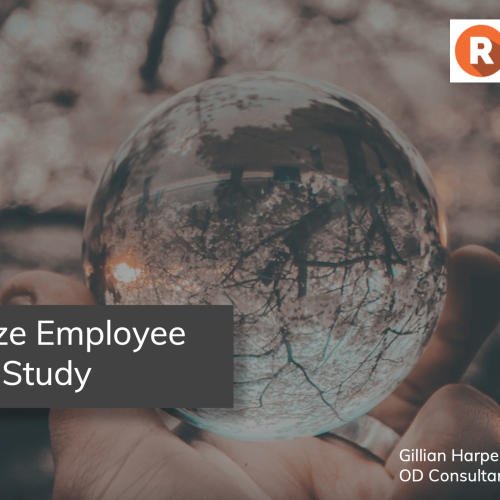Navigating Uncertainty: People-Centred Organizational Resilience
Published on May 8, 2024
The only way to make sense out of change is to plunge into it, move with it, and join the dance.
Alan Watts
Change and failure — the two unavoidable facts of life and business. Experiencing one or both can be daunting and devastating. However, the most important piece of that experience isn’t the act of change or failure itself. Rather, it’s about how you recovered, and whether you reacted or made a considered choice about how you respond.
In today’s world of business, the norm of “business as usual” is becoming increasingly more unusual. When this is the case, how do you as a leader maintain or even improve performance? How do you identify and capitalize on opportunities? How do you fortify your people?
Business as unusual: the new normal
In today’s rapidly changing world, organizations face a myriad of challenges, from economic uncertainties to technological disruptions or even global pandemics. As part of this, failure and change are unavoidable. In fact, change and failure are the things you can count on.
To thrive in this complex landscape, it is crucial for organizations to cultivate resilient people – people with the ability to adapt, recover, and even flourish in the face of adversity. Building organizational resilience goes far beyond developing contingency plans; it involves fostering a culture that embraces change, nurtures supportive leadership, encourages self-awareness, and cultivates holistic thinking. Let’s explore the four pillars of organizational resilience so that you can navigate uncertainty with grace and turn challenges into opportunities for growth and innovation.
Pillar 1: Embracing discomfort
The first pillar of organizational resilience lies in helping individuals become comfortable with being uncomfortable. Change often evokes fear and resistance. But in discomfort, there is an opportunity for growth. Embracing discomfort encourages employees to step outside their comfort zones, fostering creativity, innovation, and adaptability. When people are willing to confront challenges head-on, they become more resilient in the face of adversity, enabling the entire organization to navigate uncharted territories with confidence.
Change: exciting or stress-inducing?
The heart and pulse point of any organization is its people. Your organization’s people are also not a monolith – each person is a unique individual. As a leader, recognizing these differences and offering space to your employees as well as a variety of tools and supports to adapt to and embrace change is extremely important.
Imagine as a CEO, you announce that your organization is merging with another company. A section of your employees might be excited and think, “Interesting stuff. Great to hear. When do we get to meet the new folks?”
But for the majority of people, change brings a range of feelings from hesitation and concern to outright fear. Organizational change is likely to be highly emotionally disruptive as it is often deeply connected to one’s economic survival. If redundancies are at play, or if there are material employment changes (reclassifications of a job along with a new probationary period), an employee can quickly lose confidence and become stuck in a limbo of discomfort and stress.
Going back to the company merger scenario, most people wouldn’t be as blasé about change as the first group. Rather, the majority of staff responses would probably include:
- “What will become of me if two other office admin people are brought into our newly merged organization? Will there still be a job for me?”
- “If my job changes, am I capable of learning a new job? Should I be looking for another job?”
- “My current manager is mentoring me; I stayed with this organization for this reason – how will my mentoring arrangement be impacted by the merger?”
- “Will my new supervisor understand my disability issues as well as my current supervisor does? What if I lose my workplace accommodations?”
Workplace change exerts a wide scope of influence. Most often, the everyday person does not have control or input into organizational change. Employment also represents financial security. For those who may not have trade designations, degrees, or are new in their career, organizational “changes” can equate to stress. Further, people with barriers to employment (mental health or disabilities) are at greater risk if their jobs are reclassified, or if they lose their jobs.
To empower your people to feel comfortable being uncomfortable, as a leader, you must offer purpose and clarity around the change. Why is this change happening and how does it relate to them?
Communicate the strategic goals and reasons propelling the organizational change, and how these changes may impact their daily work and goals. Equip your managers with the proper knowledge and tools to support your frontline staff. Managers play a key part in this process as they can ensure updates are shared promptly and be change champions, addressing concerns on the spot, sharing frontline feedback with senior leadership, modelling desired changes, and more.
Pillar 2: Supportive Leadership
Supportive leadership is the backbone of organizational resilience. Supportive leadership focuses on creating a nurturing environment where employees feel valued, heard, and empowered.
Supportive leaders inspire trust, encourage open communication, and foster a sense of belonging. They provide mentorship, guidance, and resources, enabling individuals to grow and thrive. Such leaders are empathetic, understanding the diverse needs of their teams, and are willing to invest in their development. A supportive leadership style not only boosts employee morale but also creates a resilient organizational culture where individuals are motivated to overcome challenges collectively.
Supportive leadership revolves around honesty, transparency (whenever possible), kindness, and clarity. It can be difficult to be kind and honest when handling the negative sides of change, such as layoffs due to redundancies. It might feel kinder to be vague and dance around the topic of layoffs to avoid causing the discomfort of others (and yourself).
However, the reality is that this type of avoidant behaviour only causes more stress and confusion – so are layoffs happening or not? How much runway do I have before I’m out of a job? I’m already so overloaded – am I going to now be doing three jobs at once for the same pay?
Especially in these difficult situations, leaders, managers, and supervisors should all be aligned on consistent messaging to be shared with all employees. Leaders should take extreme caution to avoid making unrealistic promises (e.g., promising little to no job losses when job loss is highly probable). Supervisors and/or managers can offer one-to-one meetings for all employees to discuss how the organizational change impacts their roles and workloads.
These meetings are also an opportunity for management to ask for and listen to any concerns, fears, and feedback employees have regarding the change. Concerns can then be immediately addressed and also fed back to senior leadership. Instead of falling into the trap of conflict avoidance under the guise of being kind, be honest about how changes can affect employees in general and communicate privately and honestly with individual employees regarding how changes could impact them specifically.
Listen to Laurie Wilson, client solutions specialist in culture and risk management, share her 30-second thoughts on managing team burnout through effective supportive leadership practices.
Pillar 3: Empowering Individuals
The third pillar involves helping individuals understand themselves, their capabilities, and their strengths. Self-awareness forms the foundation of personal and professional growth. When employees have a deep understanding of their skills, values, and passions, they can make more meaningful contributions to the organization.
Committing to one’s own growth not only enhances individual resilience but also strengthens the collective resilience of the organization. Empowered individuals are better equipped to weather storms, adapt to change, and they have an increased capacity to contribute sustainably to the organization, even through times of great change.
Resilience is not reactive, it’s proactive. Empowered and self-aware employees can build up their sensitivity to change through their ability to withstand change.
In this context, “sensitivity” isn’t referring to an individual’s emotional reaction to change. Rather, “sensitivity” refers to an employee’s heightened awareness to their surroundings which enables them to better observe and identify potential changes in advance, thus gaining more time to absorb, adjust, and respond.
David Chandler, a professor of International Relations at the University of Westminster, has likened this process to a fly sensing a rolled-up newspaper and flying away to safety long before said newspaper swings down to bring about its end. When your people are empowered to be sensitive to change, they can collectively help the organization respond agilely to change, regardless of how often or the scale of change they are presented with.
So, how can you empower your people?
It begins with encouraging and actively facilitating their self-awareness. Understanding oneself and embracing individual strengths form the bedrock of personal resilience and well-being. In a world marked by constant change and challenges, self-awareness acts as a guiding light, illuminating the path toward personal responsibility and accountability.
When individuals acknowledge both their limitations and unique capabilities, they cultivate a profound sense of confidence and ownership that enables them to navigate life’s complexities with a greater sense of ease and determination. This self-awareness is not only crucial for personal growth but also for building resilience, as it fosters the ability to bounce back from setbacks and face challenges with a positive mindset.
In Canada, the responsibility of fostering psychological well-being extends beyond the individual to the workplace. Canadian employers are obligated to take all reasonable actions in creating and maintaining psychologically healthy and safe workplaces, as stipulated by occupational health and safety regulations.
This duty emphasizes the importance of nurturing a workplace environment where employees feel valued, supported, and psychologically secure. Recognizing and appreciating employees’ diverse strengths and qualities is an integral part of this process. Employers play a pivotal role in fostering an atmosphere that encourages self-discovery, acceptance, and the utilization of individual strengths. By doing so, they not only comply with legal obligations but also contribute significantly to the overall mental and emotional well-being of their workforce.
Pillar 4: Systems Thinking
The fourth and final pillar of organizational resilience is training people to use systems thinking. Traditional problem-solving often involves addressing symptoms rather than root causes. Systems thinking; however, encourages a holistic approach, enabling individuals to analyze complex situations, identify interconnections, and understand the underlying dynamics at play.
By recognizing the intricate web of relationships within and outside the organization, employees can anticipate challenges, identify opportunities, and develop comprehensive solutions. This approach equips organizations with the foresight needed to navigate uncertainties effectively.
Systems thinking views systems – be they organizational, ecological, or biological – as interconnected entities where each part influences and is influenced by the others. In the context of business, systems thinking involves analyzing the entire organization as a system, considering the relationships and interactions between its various components. Unlike traditional linear thinking, systems thinking recognizes the dynamic and interdependent nature of modern businesses, embracing complexity rather than simplifying it.
Implementing systems thinking can yield numerous advantages for an organization. Firstly, it enables a deeper understanding of the organization’s processes, identifying inefficiencies and areas for improvement. Secondly, it promotes collaboration and communication among different departments and teams, breaking down silos, and enhancing overall efficiency. Furthermore, systems thinking fosters innovation and enhances adaptability by encouraging creative problem-solving and allowing organizations to respond effectively to emerging challenges. Organizations employing systems thinking can make more informed decisions by focusing on long-term consequences, leading to sustainable growth and profitability.
Training staff in systems thinking is essential for organizations aiming to harness these benefits. Firstly, employees need to develop a fundamental understanding of systems theory and its relevance to the organization. Workshops and online courses can facilitate this learning. Additionally, practical exercises, such as mapping out processes and identifying feedback loops using free mapping tools such as Kumu, can help employees visualize and so understand complex systems.
Employing a systems-thinking approach as standard also allows organizations to naturally encourage a culture of questioning and curiosity. Staff should be empowered to challenge assumptions and explore the underlying causes of problems. This can be fostered through open forums for discussions, regular brainstorming sessions, and encouraging feedback loops within the organization.
Another idea could be establishing mentorship programs where experienced employees guide their peers in applying systems thinking to real-world challenges which the organization is facing. Learning from practical examples like this can reinforce the application of systems thinking principles in day-to-day operations.
Organizations can enhance their adaptability, efficiency, and overall performance by investing in staff training, promoting a systems thinking mindset and modelling this mindset and associated behaviours at the leadership level, thus ensuring long-term success in today’s dynamic and interconnected economic landscape.
Next steps
Building organizational resilience goes far beyond developing operational contingency plans. When an organization prioritizes fostering a supportive culture, building systems that empower individuals, and leading with kindness, their people will have the ability adapt to, recover from, and even flourish in the face of adversity. Being adaptable to change instead of being paralyzed with fear allows organizations to navigate uncertainty with grace and turn challenges into opportunities for growth and innovation.
Contributors

Alison Marshall
Client Solutions in Strategy and Leadership



